Non-heme iron is known as “plant iron” and is characterized by relatively low bioavailability: Plant iron is absorbed less than iron from animal foods, which is why non-meat eaters are often believed to be at higher risk of deficiencies. This might be true in some cases, but when we know how, iron absorption can be significantly enhanced by vitamin C and fruit intake.
To understand the role of fruits in iron absorption, we need the bigger picture in nutrition: The natural human diet is frugivorous, meaning very high in fruits – tropical fruits, in particular. Humans – and all apes -have lost the ability to produce vitamin C internally. But while apes still get what they need from their diet, we do not. If we stick to the foods and diet we have evolved to eat, iron from plants is sufficient for our needs if we stick to the foods and diet we have evolved to eat.
This article explains the biological difference between plant and animal-based iron and points out tropical fruits as a powerful tool for getting enough non-heme iron from plants.
Iron in our body
The main function of iron is oxygen transport in hemoglobin (in red blood cells) and energy production. Thus, iron is literally vital as a part of our life force!
Most of our iron is in the blood, bound to hemoglobin (the red molecule that gives our blood its color) to deliver oxygen to cells.
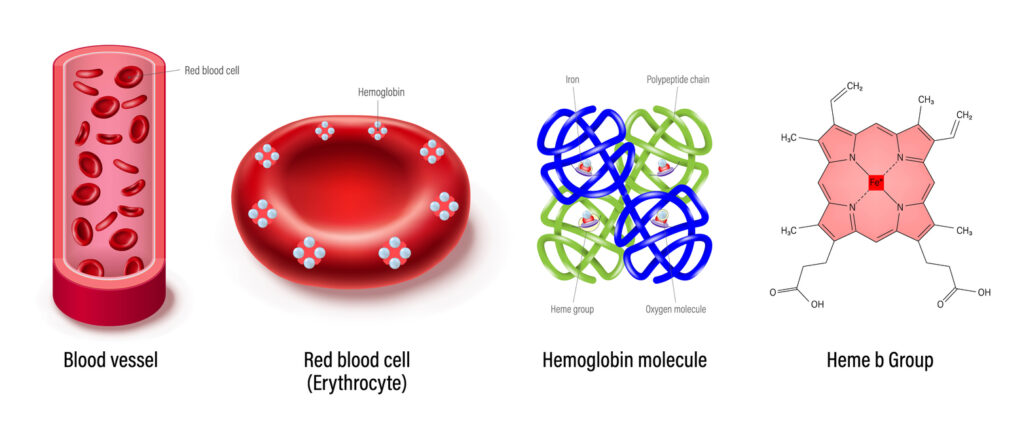
Free iron is toxic in the body because it creates reactive oxygen species ROS. This is why iron is “packed” into other molecules: The body produces specialized proteins to transport iron (transferrin) and to store iron (ferritin, see image; myoglobin in muscles). This way, there is very little free iron in the body.
Image: illustration of the complex ferritin protein (blue structures), which safely stores iron (red dots) in our body.
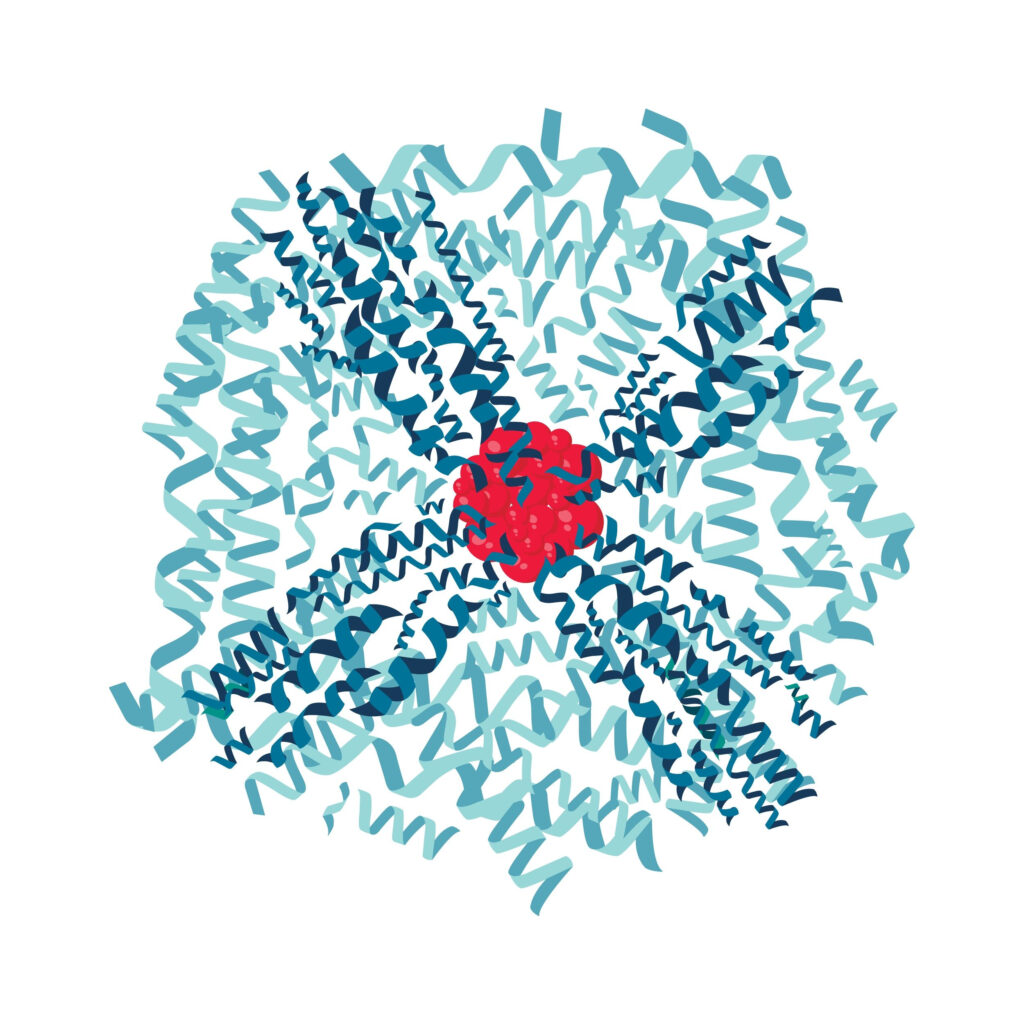
If you are iron-depleted, usually your iron storage drops first, as the body uses the iron to build hemoglobin. However, once iron storage is largely depleted, there won’t be enough iron to build blood, which will deprive you of oxygen and energy.
Thus, the typical symptoms are fatigue, dizziness, cold extremities, and muscle weakness. The visual signs of low iron can be a helpful indicator: brittle nails, typical nail ridges (see image), hair loss, hormonal problems and heavy periods, patchy or burning tongue, paleness of skin and mucous membranes, dry and cracky skin, and changes in skin pigmentation are the most typical, but not the only ones.
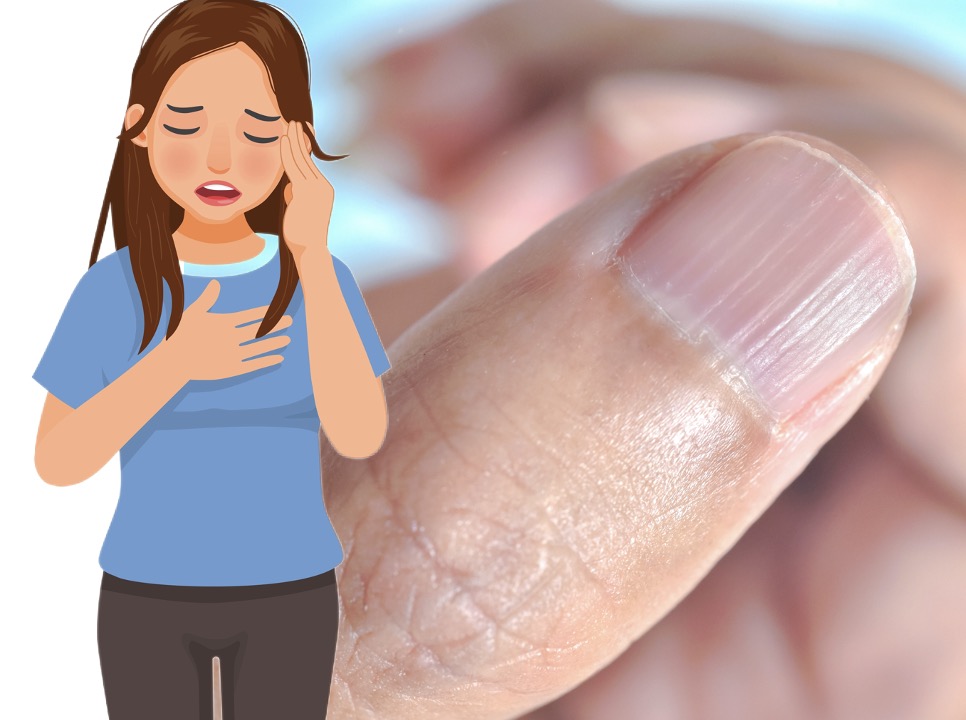
How much iron do we need from food?
Adults need to get around 8 mg (men) or 15-18 mg (women) of iron from foods daily (source). If you do not eat meat, you need 80% more iron, meaning approximately 14-15 mg for men and 27-32 mg of non-heme iron a day.
Unfortunately, having enough iron seems challenging, especially for women and people on a plant-based diet, because iron is not as easily obtained by our body from plants as it is from animal sources. Here is the good news, though: we can address this issue when looking at the bigger in nature and find the missing key to tackle the issue of poor plant iron bioavailability!
Iron from plants vs iron from meat
Iron can be consumed from plants or animal foods. Plant iron can be difficult to absorb, which is why many turn to animal-based iron for help. But animal iron is a no-go and repulsive to many who do not like to get their iron from blood! To understand the difference between the two types of iron – and how our body absorbs them – we need to take a step back and look at the food sources.
Plants contain only non-heme iron
Plant iron is mostly found in the vacuoles of leaves, fruits, and seeds in its ferric form (Fe3+). Iron in plants is fully non-heme iron, in contrast to animals. However, Fe3+ is poorly absorbed from the intestinal mucosa without “helpers” to get absorbed – in particular, enough vitamin C. An important reason that we don’t get enough iron from plants (besides intestinal issues) is that we do not stick to our – naturally – vitamin C-rich diet! Not getting enough of the right foods and getting too much of iron-absorption-blocking foods and intestinal irritants (anti-nutrients, coffee, phenolic compounds, calcium-rich dairy, etc.).
1. Greens as iron source
Green foods are important iron sources because most of the iron in plants is located in the green parts.
The chlorophyll-rich chloroplasts are the organelles that give green plant parts their color and contain most of the iron and magnesium:
“Chloroplasts represent the Fe-richest organelle in plant cells containing 80–90% of the Fe found in leaf cells” López-Millán, 2016
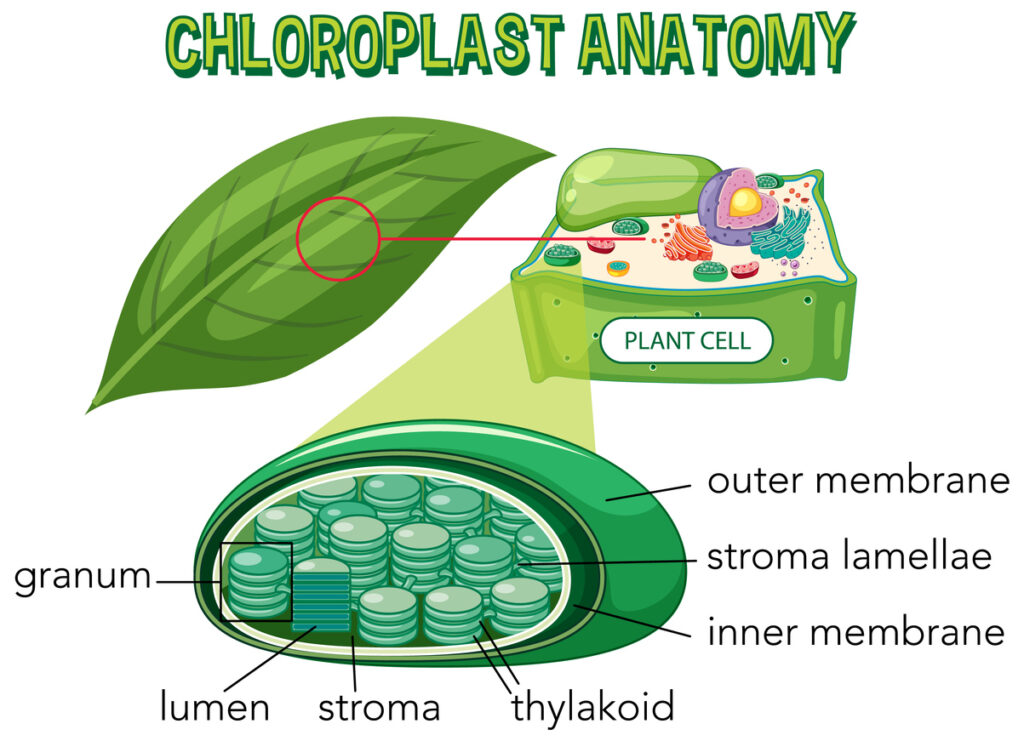
Image of a lettuce leaf under a microscope. Chloroplasts (specialized vacuoles in green cells) are the plant cell structure with the most iron because the mineral is needed for the production of chlorophyll and photosynthesis.
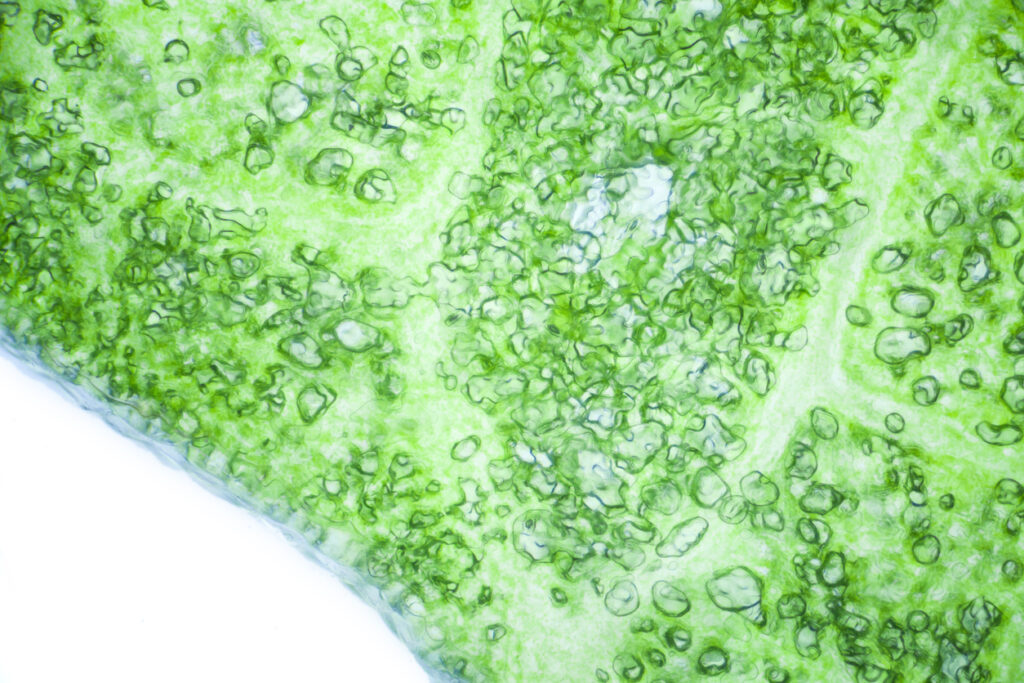
2. Fruits as an iron source
Fruits also contain significant amounts of iron: Many tropical fruits with seeds and berries are good iron sources. While green foods are the main iron pools, fruits also contain the “absorption-booster” vitamin C. Additionally, we can eat much more fruits – in terms of quantity – compared to greens.
Image: Tropical fruits, berries, and seeded fruits are great iron fruit-based sources.
For example, passion fruit contains 1.6 mg of iron per 100g, and açai berries and blackberries contain 0.6 mg of iron per 100g.
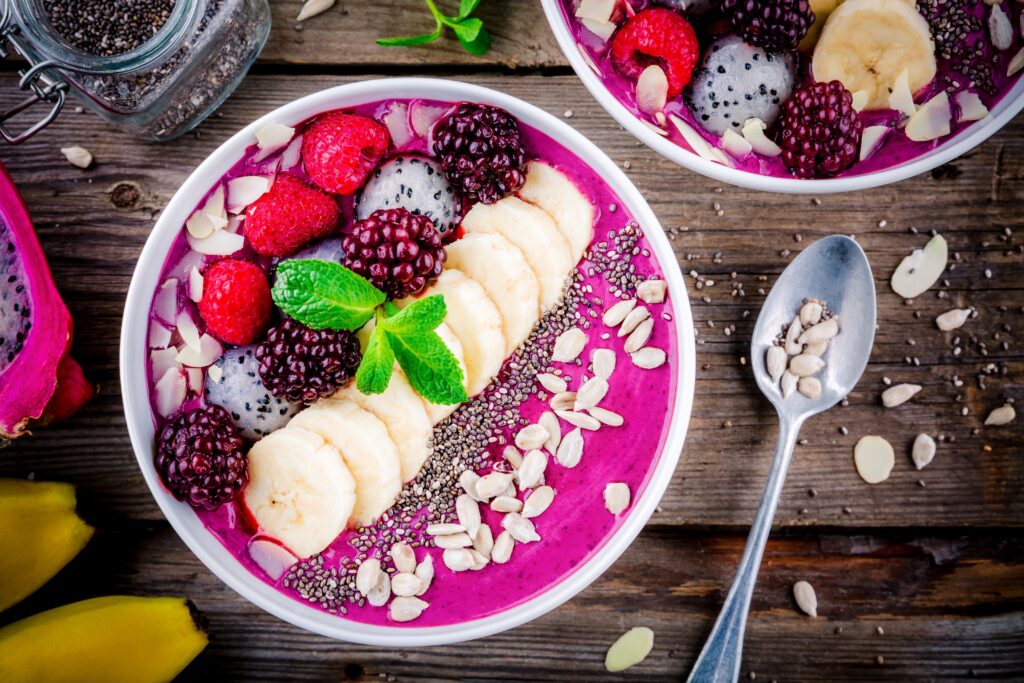
Image: Ripe fruits are made up of cells with very large vacuoles that store liquids, nutrients, and secondary metabolites that create the typical fruit color, smell, and taste of the fruit.
While fruit cells do not contain iron-rich green chloroplasts, they have huge vacuoles that do contain iron as a mineral.
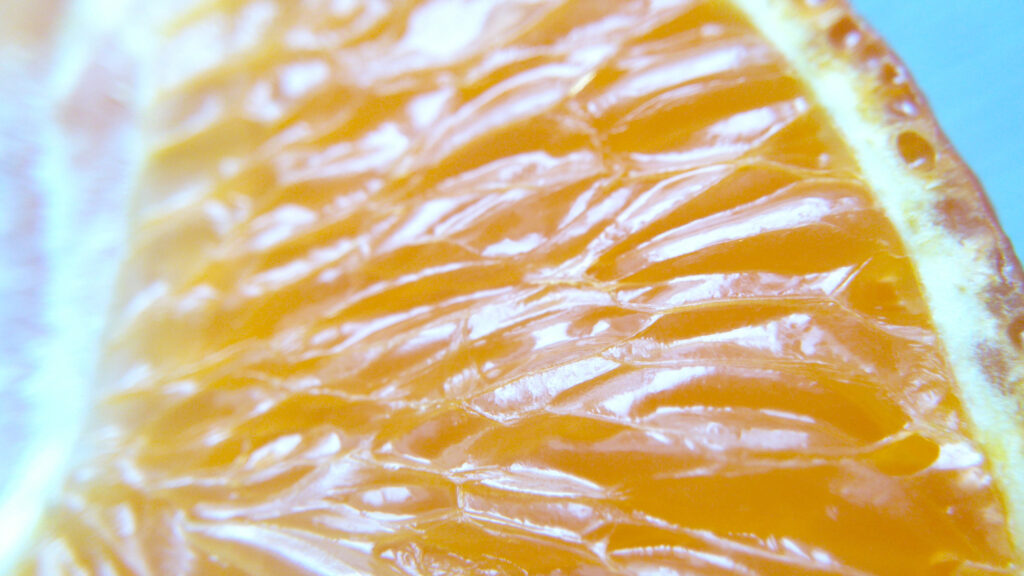
Animal foods contain heme iron and non-heme iron
Heme-iron is only found in animal foods, but animal foods also contain more than 50% of non-heme iron. Heme iron is in its ferrous from (Fe2+) and is better absorbed than non-heme iron. Heme-iron gets its name from hemoglobin: the iron is organically bound to the animals’ hemoglobin – and, thus, nothing else than “blood iron.” This is the reason why the newer heme iron supplements are less harsh on the body and the gut than non-heme iron supplements, which contain “free” unbound iron. Still, the pros of heme iron supplements do not really take away from the “creepiness” of blood iron in a capsule.
Heme iron is better absorbed and more bioavailable than non-heme iron. It’s also not affected in its uptake by certain foods (inhibitors or enhancers) compared to plant iron. The reason why heme iron is easier to absorb is because it is in a non-toxic organic form – the same form as our own iron.
Iron in animal blood: The iron from animal foods comes from their blood. The animals themselves obtain it from plant foods! Thus, all iron comes from plants originally – the key is to enhance the non-heme iron bioavailability and enable better absorption!

Almost half of the animal-derived iron comes from their blood. The animal’s blood provides a mineral needed to build human blood.
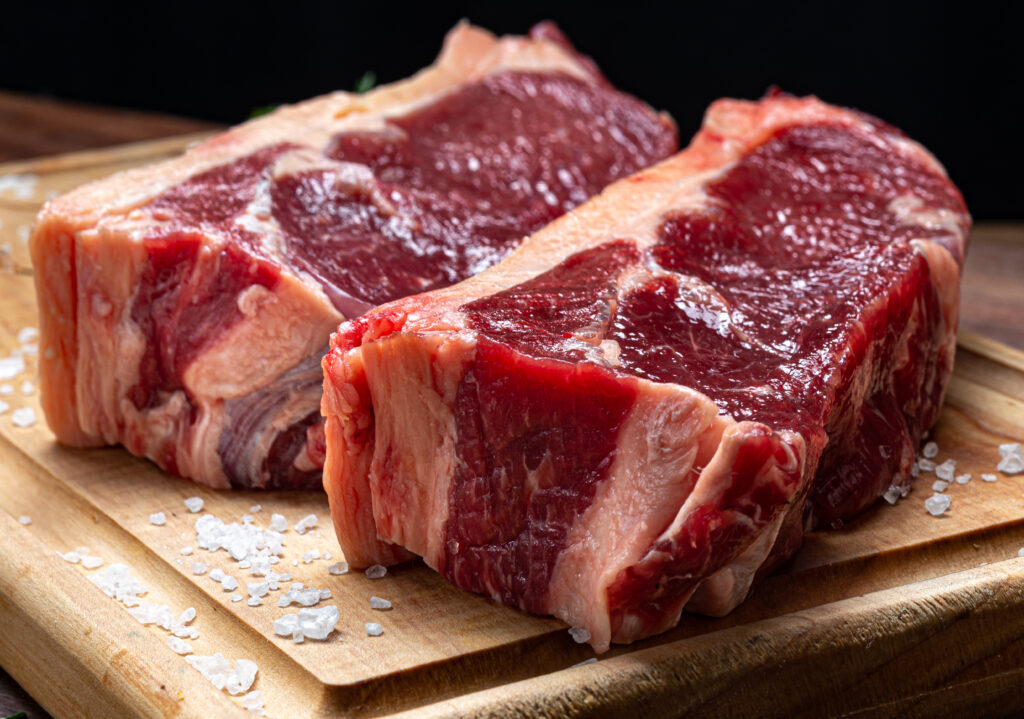
Do we need heme iron?
Heme has been called an essential nutrient despite humans not needing to consume the heme or heme iron from other animals. We build our own heme and hemoglobin! Those compounds are built in the body, and we do not need them from an external source! Heme is a blood protein that animals build. Like all proteins, it’s made from amino acids, and humans can build it de novo when iron is present. Plants are a sufficient and healthy source of iron! The secret is how to learn how to absorb it properly.
Knowing what heme-iron really is, is quite disturbing for ethical vegans and animal lovers, which is why heme-iron is not an option in many cases. But luckily, we can get enough iron from plants if we do this right!
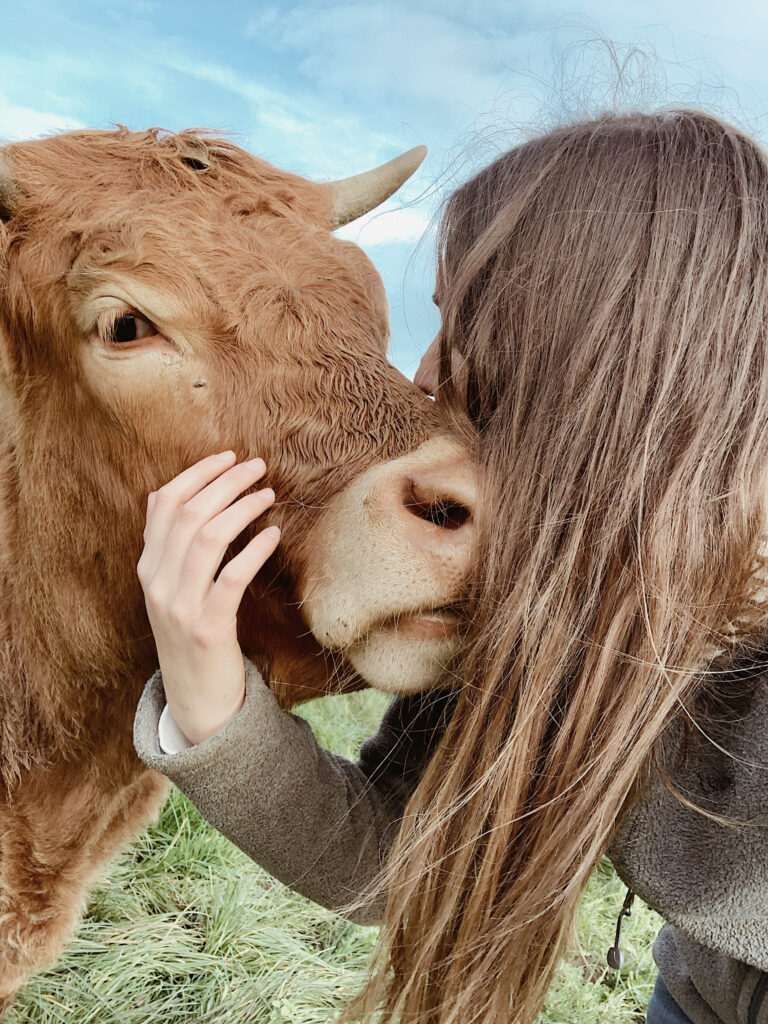
To approach this the natural way, we first should look at our biology: we are frugivores, like all other apes. We are not herbivorous ruminants (like cows or goats) that can get iron more easily from greens due to their adapted, specialized guts. Frugivores have another hack, though: Fruits and their high vitamin C, fructose, and inulin content! And, yes, fructose from fruits is actually a beneficial nutrient for us.
Fruits are the key to absorb non-heme iron
There are enhancers and inhibitors that affect how well we can take up iron:
The main iron booster food is fruit due to vitamin C, fructose, and inulin, the nutrients that increase the bioavailability of iron! There are other nutritional factors and co-factors, like magnesium, copper, zinc, and vitamin D that play a role in iron status and hemoglobin production. On the other hand, iron status affects other nutrients, like vitamin B12 and folate.
The inhibitors are many compounds in plant-based and animal-based foods: phytic acids, polyphenols, calcium, excess protein, and oxalate, which are present in many foods. The main culprits are coffee, green and black tea, and dairy.
The crucial role of fruits and vitamin C in non-heme iron absorption has long been known. Iron builds a chelate with vitamin C in the gut, reducing ferric iron (Fe3+) to ferrous iron (Fe2+) and enhancing absorption. Ferrous iron is the form we find in animal-based, heme iron:
“Ascorbic acid is a powerful enhancer of nonheme iron absorption and can reverse the inhibiting effect of such substances as tea and calcium/phosphate. The enhancement of iron absorption from vegetable meals is directly proportional to the quantity of ascorbic acid present.”
Lynch and Cook, 1980
Further, vitamin C decreases our intestinal “iron blocker” hormone hepcidin. Vitamin C also counteracts the oxidative stress of free iron with its anti-oxidative effects.
However, the current vitamin C intake is much too low, which explains why many struggle with getting enough iron from plants:
While the RDA of vitamin C lies between 70 and 95 mg, humans actually need around 2000-3000 mg of vitamin C daily – like other mammals and our closest relatives, the chimpanzees! We’d get enough vitamin C (and thus, effective non-heme iron uptake) if we adopted our natural diet, which is very high in fruits! Why? It’s still written in our genes as the descendants of fruit-eaters:
Learning from chimpanzees: the role of tropical fruits for iron!
Humans are anatomically and physiologically still frugivores (fruit-eaters), which is why the chimpanzee diet can serve as an approximation to our own natural diet! In nature, our closest relatives eat a frugivorous diet. Staple foods are mostly tropical fruits, green leaves, nuts, and seeds, and smaller amounts of other types of foods. Frugivores have lost their vitamin C genes and depend on a high vitamin C intake from external sources. Humans are no exception. We have lost our vitamin C genes but do not consume nearly as much fruit as we have evolved to eat.

Note: Nutritional requirements are known to be highly similar in humans and chimpanzees! So much so that the nutritional RDAs established for humans are also used for chimpanzees in zoos. Vice versa, we can – and probably should – learn from chimpanzees’ diet and nutrient intake in the wild.
“Many fruits and unconventional foods are available in the tropics and represent valuable minerals sources. Green leaves appear as outstanding mineral sources, especially in calcium and iron, followed by nuts.” (Leterme et al., 2006)
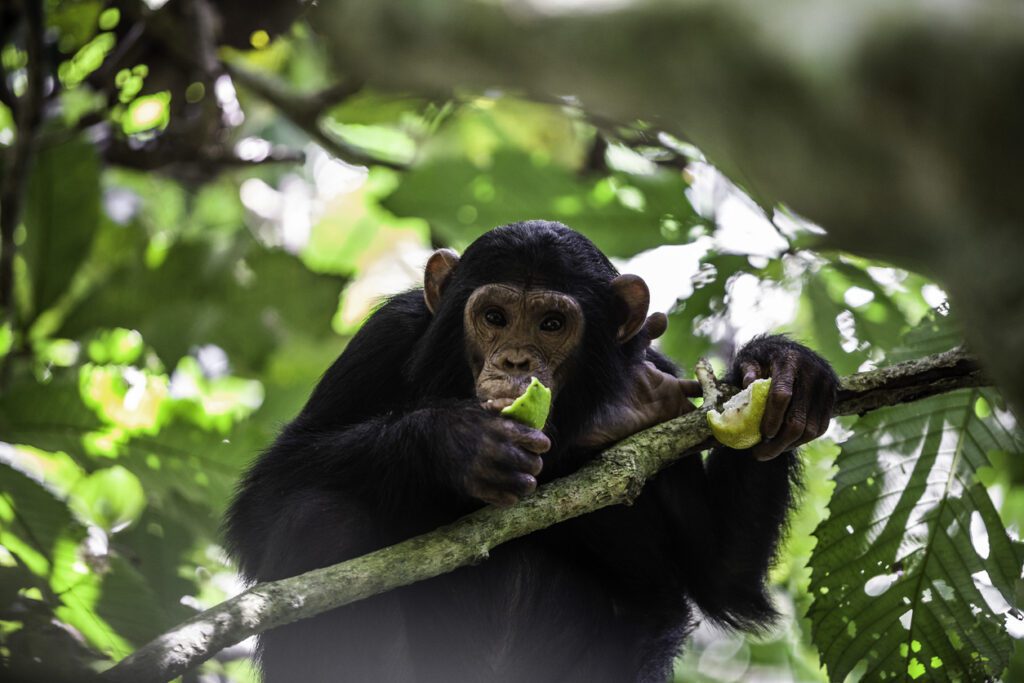
Fruits and greens as iron sources: Fruits contain somewhere from 0.3 – 1.5 grams of iron per 100 grams. Tropical fruits and seeded fruits tend to have more than temperate fruits. While fruits can contain less than iron-rich green foods, we have to consider that we naturally eat fruits in much more quantities than greens! For example, chimpanzees (30-60 kg body weight) eat around 3-6 kilos of fruits, which is around 10-30 grams of iron. Further fruits come with the plus of containing vitamin C, inulin, and natural fructose, which helps absorb the non-heme iron while containing little iron absorption inhibitors. Therefore, chimpanzees reach the iron they need via their frugivorous diet.
What can you do to get enough iron from plants?
One of the best things that you can do for your health and nutrient intake – including iron – is to adopt a diet very high in fruits: Get a good amount of your calories from tropical fruits and berries, and add large salad bowls with greens and fruits, citrus-based dressings, and seeds as a staple food. Consider taking natural vitamin C supplements to reach the amount of vitamin C that we need as mammals and as frugivores, which is around 2000-3000 mg daily.
This is just a short summary of the role of fruits in getting plant-based iron. Besides fruits, there are more nutrients and factors that affect the successful uptake of non-heme iron. Learn more in-depth about how to get enough iron from plants in our iron protocol!
References
- Office of dietary supplements – iron (no date) NIH Office of Dietary Supplements. Available at: https://ods.od.nih.gov/factsheets/Iron-HealthProfessional/ (Accessed: 06 September 2023).
- Galaris, D., Barbouti, A. and Pantopoulos, K. (2019) ‘Iron homeostasis and oxidative stress: An intimate relationship’, Biochimica et Biophysica Acta (BBA) – Molecular Cell Research, 1866(12), p. 118535. doi:10.1016/j.bbamcr.2019.118535.
- G. Hochmuth (2018) Iron (Fe) nutrition of plants. Available at: https://edis.ifas.ufl.edu/publication/SS555# (Accessed: 06 September 2023).
- López-Millán, A.F., Duy, D. and Philippar, K. (2016a) ‘Chloroplast iron transport proteins – function and impact on plant physiology’, Frontiers in Plant Science, 7. doi:10.3389/fpls.2016.00178.
- Schmidt, W., Thomine, S. and Buckhout, T.J. (2020) ‘Editorial: Iron nutrition and interactions in plants’, Frontiers in Plant Science, 10. doi:10.3389/fpls.2019.01670.
- Jiang, Y.-T. et al. (2021) ‘Multiple functions of the vacuole in plant growth and fruit quality’, Molecular Horticulture, 1(1). doi:10.1186/s43897-021-00008-7.
- Monsen, E.R. (1988) ‘Iron Nutrition and absorption: Dietary factors which impact iron bioavailability’, Journal of the American Dietetic Association, 88(7), pp. 786–790. doi:10.1016/s0002-8223(21)07902-5.
- Lynch, S.R. and Cook, J.D. (1980a) ‘Interaction of vitamin C and iron’, Annals of the New York Academy of Sciences, 355(1 Micronutrient), pp. 32–44. doi:10.1111/j.1749-6632.1980.tb21325.x.
- Hooda, J., Shah, A. and Zhang, L. (2014) ‘Heme, an essential nutrient from dietary proteins, critically impacts diverse physiological and pathological processes’, Nutrients, 6(3), pp. 1080–1102. doi:10.3390/nu6031080.
- Piskin, E. et al. (2022) ‘Iron absorption: Factors, limitations, and improvement methods’, ACS Omega, 7(24), pp. 20441–20456. doi:10.1021/acsomega.2c01833.
- Timoshnikov, V.A. et al. (2020) ‘Redox interactions of vitamin C and iron: Inhibition of the pro-oxidant activity by deferiprone’, International Journal of Molecular Sciences, 21(11), p. 3967. doi:10.3390/ijms21113967.
- S. Pollack, S., R.M. Kaufman, W.H. Crosby (1964) ‘Iron absorption: Effects of sugars and reducing agents’, Blood, 24(5), pp. 577–581. doi:10.1182/blood.v24.5.577.577.
- Christides, T. and Sharp, P. (2013) ‘Sugars increase non-heme iron bioavailability in human epithelial intestinal and liver cells’, PLoS ONE, 8(12). doi:10.1371/journal.pone.0083031.
- Milinković, N. et al. (2022) ‘Magnesium supplementation and iron status among female students: The intervention study’, Journal of Medical Biochemistry, 41(3), pp. 316–326. doi:10.5937/jomb0-33898.
- Copper (2023) Linus Pauling Institute. Available at: https://lpi.oregonstate.edu/mic/minerals/copper#:~:text=Adequate%20copper%20nutritional%20status%20is,livers%20of%20copper%2Ddeficient%20animals. (Accessed: 06 September 2023).
- Kondaiah, P. et al. (2019) ‘Iron and zinc homeostasis and interactions: Does enteric zinc excretion cross-talk with intestinal iron absorption?’, Nutrients, 11(8), p. 1885. doi:10.3390/nu11081885.
- Malczewska-Lenczowska, J. et al. (2018) ‘The association between iron and vitamin D status in female elite athletes’, Nutrients, 10(2), p. 167. doi:10.3390/nu10020167.
- Remacha, A.F. et al. (2015) ‘Vitamin B12 and folate levels increase during treatment of iron deficiency anaemia in young adult woman’, International Journal of Laboratory Hematology, 37(5), pp. 641–648. doi:10.1111/ijlh.12378.
- Chiu, P.-F., Ko, S.-Y. and Chang, C.-C. (2012a) ‘Vitamin C affects the expression of hepcidin and erythropoietin receptor in hepg2 cells’, Journal of Renal Nutrition, 22(3), pp. 373–376. doi:10.1053/j.jrn.2011.09.007.
- Fulk, R., M. Loomis and C. Garland (1992) Nutrition of captive chimpanzees. In: The care and management of chimpanzees in captive environments. Chimpanzee Species Survival Plan – Husbandry Manual. Fulk, R. and C. Garland, Eds. American Association of Zoos and Aquariums Available at: https://nagonline.net/wp-content/uploads/2013/12/Chimpanzee-Nutrition.pdf (Accessed: 06 September 2023).
- Milton, K. (1999) “Nutritional characteristics of wild primate foods: Do the diets of our closest living relatives have lessons for us?,” Nutrition, 15(6), pp. 488–498. Available at: https://doi.org/10.1016/s0899-9007(99)00078-7.
- Leterme, P. et al. (2006) “Mineral content of tropical fruits and unconventional foods of the Andes and the Rain Forest of Colombia,” Food Chemistry, 95(4), pp. 644–652. Available at: https://doi.org/10.1016/j.foodchem.2005.02.003.


Add Comment